Introduction:
Welcome to the awesome Studio Brootle U-he Bazille Tutorial! For each section there’s a free preset and a description of what is happening. Hope you find it useful.
Without doubt U-he Bazille is my favourite plugin, it is an amazingly powerful FM synth, housed in a Eurorack style design. But many producers get stuck with as it is so different to other VSTs, and often they don’t dig deep into it due to the complexity of it’s oscillators. This article is to help users get over that hurdle, as beyond that is a highly usable and very powerful sound design tool.
In this tutorial I present some examples of simple usable patches to show what the synth is about and get over many teething issues.
This is aimed at producers who’ve used other vsts or hardware synths before and understand envelopes / oscillators and the like. With any such guide it will be too complicated for some and not technical enough for others! If you find it too much – it is well worth going through the Bazille manual as it is excellent. Any questions, please feel free to get in touch and let us know 🙂
See also: Brootle Bazille Preset Pack, See also : You can find all of our VST presets here. Studio Brootle 909 Sample Pack, House Drum Patterns, VCV Rack Tutorial. And our presets for Repro-1 ,
U-he Bazille Tutorial
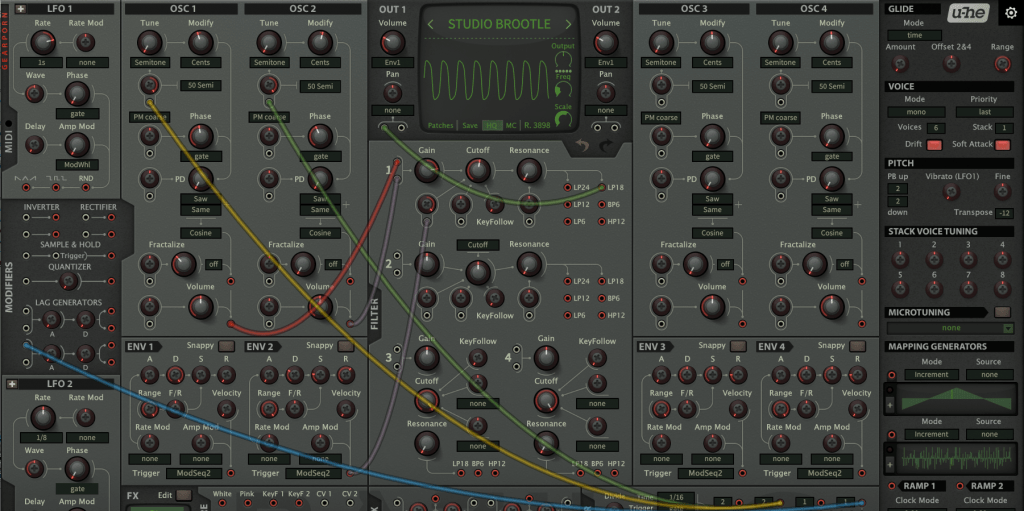
So what is Bazille? Although it looks like an analog modular – it is a digital synth that does FM excellently. It’s laid out like a Eurorack synth, but it it has four powerful digital FM oscillators routed through analog modelled filters, plus some very good fx and routing options.
A bit about FM synthesis:
For anyone unaware of FM synthesis: It is very different to analog (subtractive) synthesis (like the Roland tb-303 or Minimoog) where the oscillator(s) generate the harmonic content and are then filtered to sculpt the sound. FM synthesis is where an oscillator’s pitch is modulated by the pitch of another oscillator to create a new tone. Both normally sine waves. When you add envelopes to this process (to control the amount of modulation) you get basic FM synthesis. FM synths were massive in the 80s – examples include the Yamaha DX7 and Casio CZ-101. Often these were complex to program as the synths had tiny screens and were a real pain to get your head round the modulation routings on those screens and menus!
With Bazille, Urs Heckmann made this really easy with modular wires showing the routings. And the multiplexes for mixing and combining signals, rather than menus and grids to get to grips with quite complex modulation routings, you can now see them easily.
Bazille has a few filters too (many FM synths do not), and these model analogue subtractive synths, with the ability to drive/distort the signal into the filter like you can on a Moog or MS20 for example. Which is really nice tbh!
Bazille presets
The following tutorial sections all include presets for the sounds made, download them and see how you get on. (See also: Brootle Bazille Preset Pack for more patches for this synth.)
Basic FM with Bazille:
Here is an example of basic fm, which is the heart of what Bazille does. Our example is quite abrasive, and FM can be used for industrial metallic sounds like this, or more subtly for string and pluck type sounds.
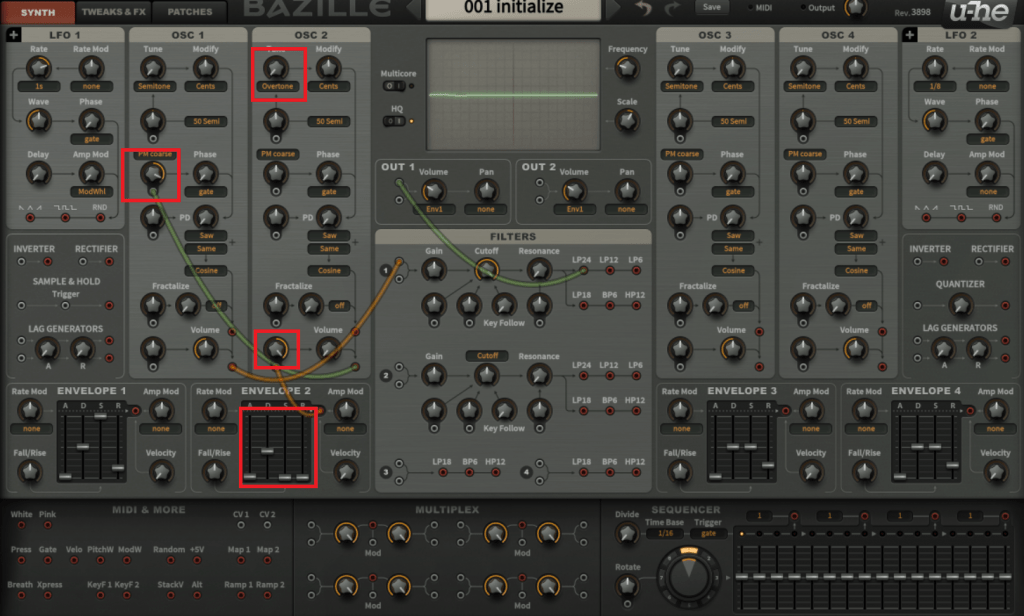
What is happening here is only oscillator 1 is routed to the audio output. So you are hearing Oscillator 1. Oscillator 2 is routed to frequency modulate the pitch of Oscillator 1.
Envelope 2 controls how much the frequency modulation comes through across the duration of a note.
Try making these adjustments so you can hear what is happening: Change the Osc 1 PM course knob up and down to hear how much the frequency is modulated. Tweak Osc 2 Overtone (the pitch of Osc 2). Also Osc 2 volume modulation control to hear how much the envelope effects the volume of Osc 2 (which is the FM source). Tweak Envelope 2 to hear how the envelope affects the FM over the duration of a note being played. Note that the volume knob for osc 2 is at zero.
Bazille does FM/PM (phase modulation ala Yamaha DX7) and PD (phase distortion ala Casio CZ-101) to modulate the oscillator.
The Oscillators
Here is where Bazille can seem a bit complicated, so stick with me! It’s not as crazy as it seems.
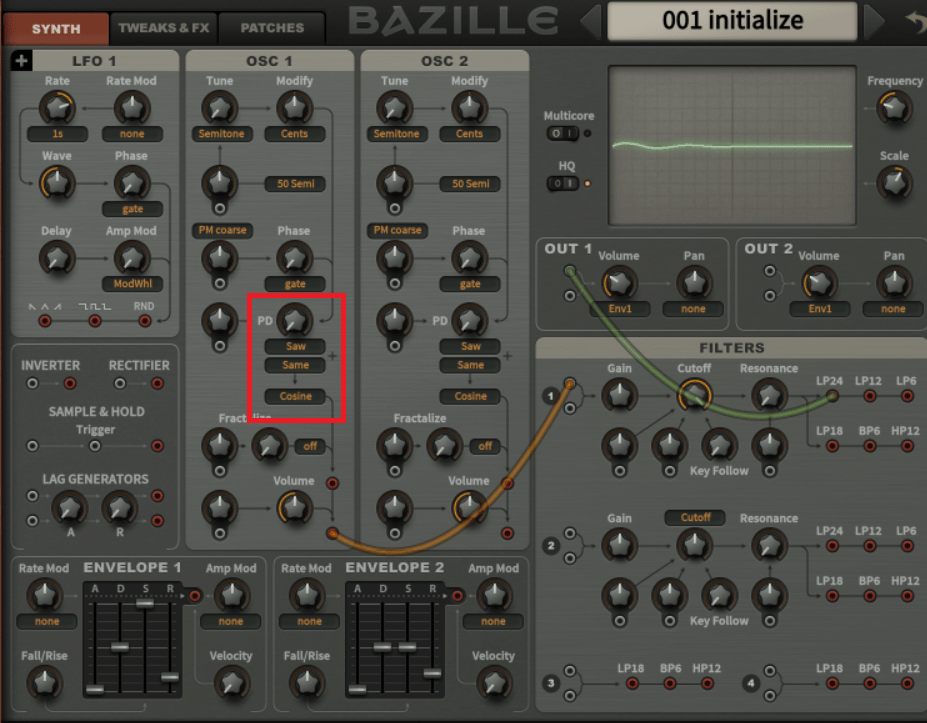
If you turn the PD knob all the way left you will get the cosine waveform (similar to a sinewave). This is the wave with no FM.
By turning the PD knob to the right the wave will phase distort into a saw wave (using the settings in the image). This is the FM. It is sort of like imposing a saw wave onto a sinewave (in the image even though it says it’s a saw, it is a cosine playing, as the saw pd has not been applied to it).
Saw + ‘same’ is 2 saw waves looping. Saw + Square is a singular saw wave followed by a singular square wave and then repeated. Play a long note and turn the PD all the way right and then look at the waveforms in the oscilloscope and change the types, you’ll see how it changes. It is a waveform made up of the 2 waveforms listed.
TapMaps
This presets shows the TapMaps feature- where you can draw waveforms.
Change the Shape from Cosine to a tapmap and then you can draw in the waveform in the tapmap editor instead of a cosine function. You can change the Cosine shape for each oscillator to TapMap1 or TapMap2 by clicking on ‘Cosine’. Then if you go to the Tweaks tab you can edit it and actually draw your own wave form. In this example keep the PD knob all the way left/anticlockwise as per the diagram so there is no PD frequency modulation on the waveform.
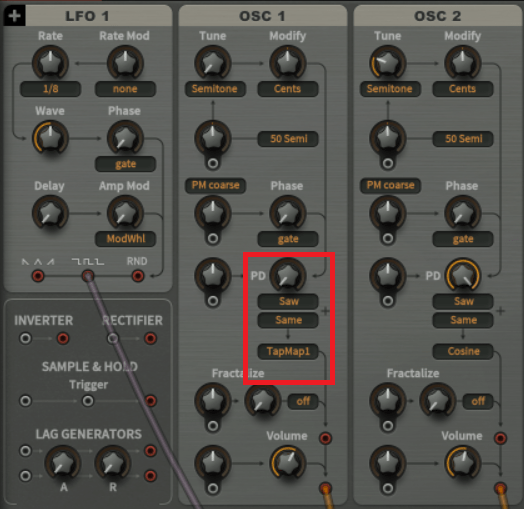
You can then draw a shape in Mapping Generator 1 with the mouse as in this image, you can see the wave form you drew in the oscillator too, when you play a note, both are the same. You can now draw in waveforms!
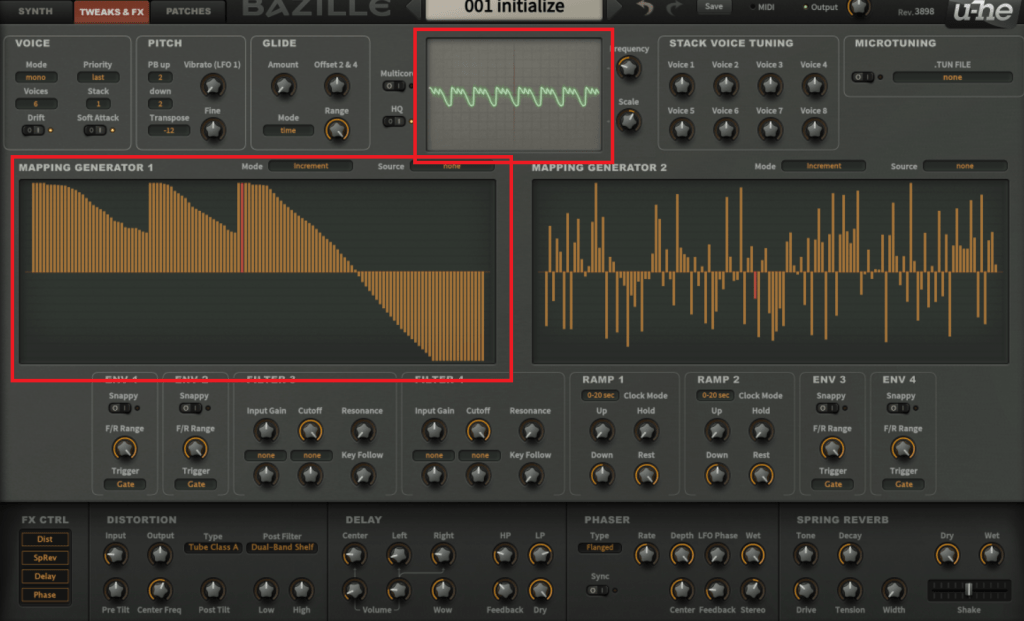
If you right-click (I’m on a pc) on the Mapping Generator you get a lot of options to generate shapes. One interesting feature is the ability to select every 2nd/3rd/4th step and then apply a different shape to that. For example try drawing a random shape, then right-click ‘selection’ the ‘every 4th’, then right click and click ‘invert’.
There are a lot of interesting features here to try out. You can often just end up with noise though, be careful!
Fractalize
Bazille’s fractalization is difficult to explain, it is easier if you see it in practice than it is to describe it. Start with a sine wave (pd knob all the way to the left) and then add set the Fractalize to Saw and slowly turn up the amount whilst looking at the oscilloscope you can see that the sine wave exists in a saw wave structure. Turn it all the way and back while look at the scope and you’ll see what it does. You can get some very nice sync-sounding sweeps out of it.
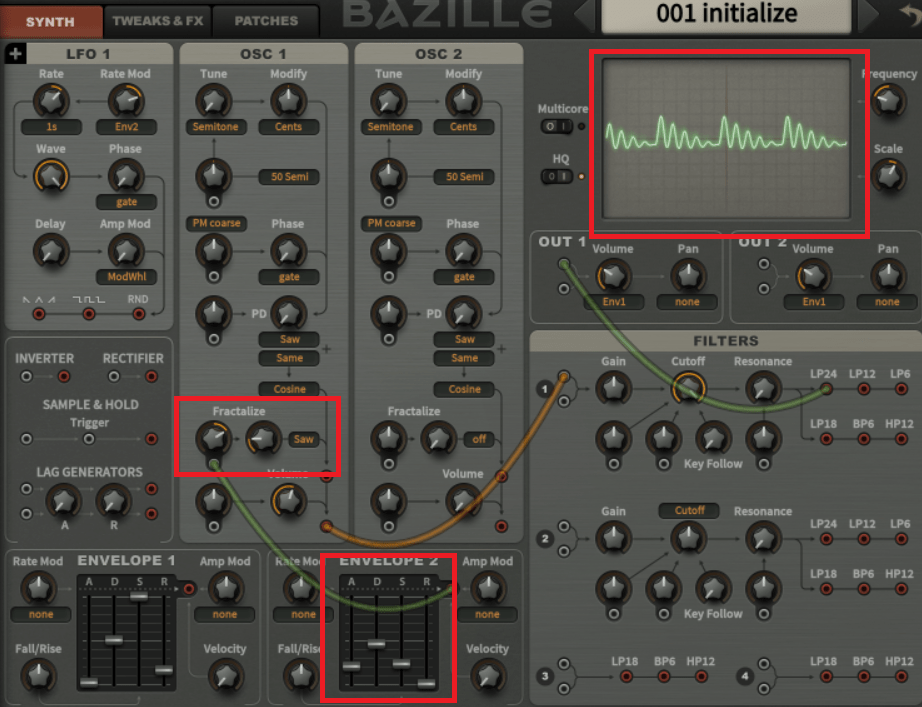
Here I have added an envelope (with a bit of attack) to the mod. You can get some mental sounding sirens out of it this way.
Further tweaking: if you set the fractal amount higher and the mod amount in the negative you can get some vowel type sounds too.
The filters: basic filter envelope and filter FM
These presets show some basic modulation of the filters.
There are two different cut-off modulations here:
1. simple envelope – turn up the cut off mod labelled 1 to hear the effect of envelope 2 on the cut-off filter.
2. filter frequency modulation – turn up the mod labelled 2 in the image below and the cutoff will modulate at the frequency of osc 3. This is a great effect for drones etc.
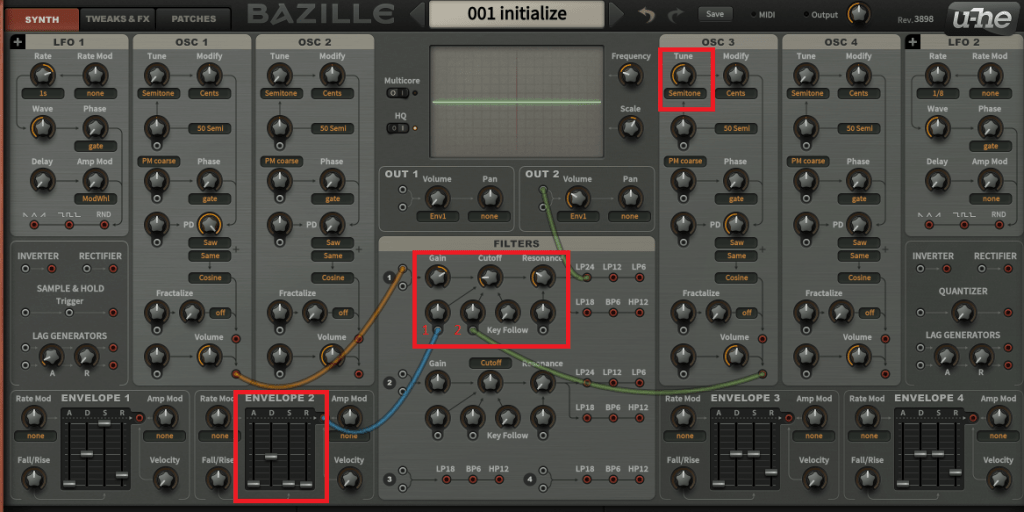
Some things to try: adjust envelope 2’s settings. Try filter FM on different filter types and change the pitch and waveforms of the modulation source oscillator etc. Also the filter gain is a nice overdrive – whack it up!
Multiplex examples.
The multiplex is a simple mixer. But it can be used for some relatively complex functions. One simple use is to route all OSCs to the master out or to a filter for example.
Here are 2 examples to get started with it:
cross fading: here osc1 and osc 2 alternate between each other at a rate set by lfo 1. This can be useful for pads – i.e. to fade between an oscillator and another similar osc a 5th higher for example.
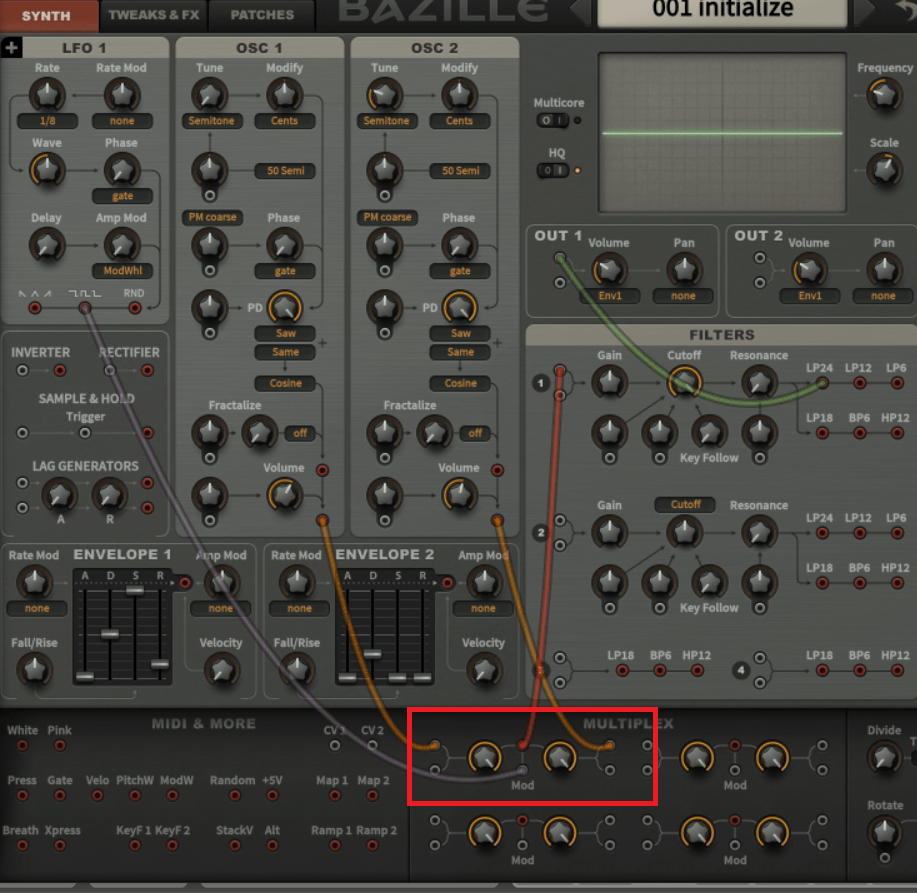
Ring mod: by routing osc 2 to the mod you get a ring mod effect.
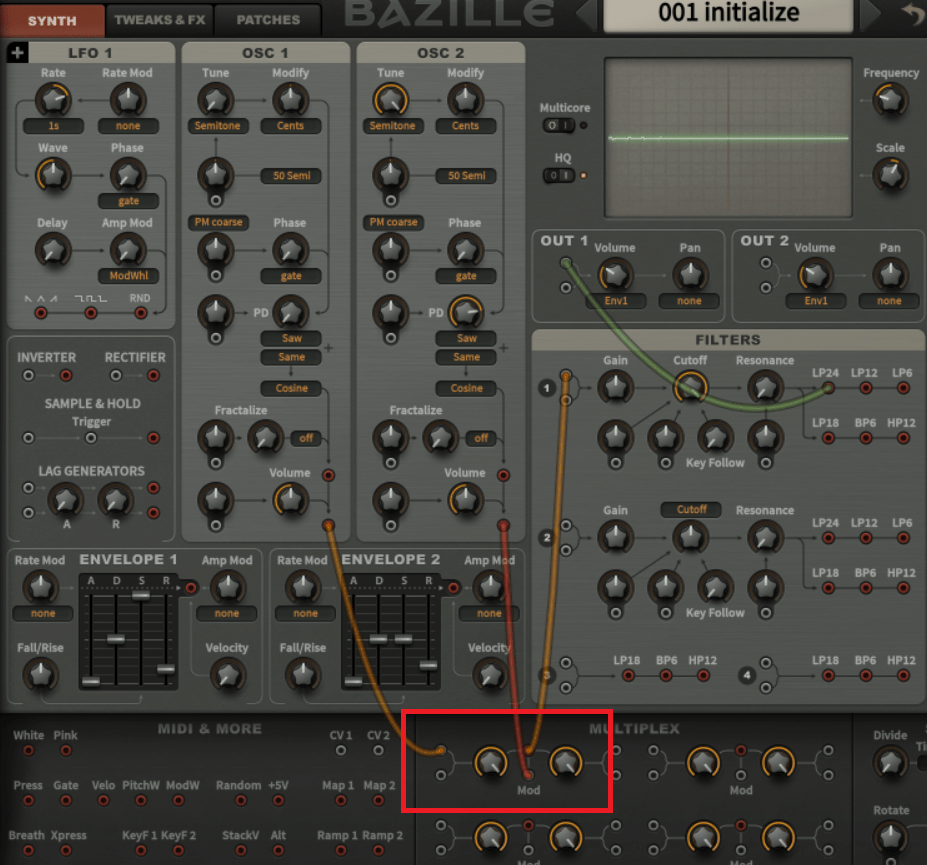
Sub Bass
Here’s an example of a simple sub-bass with pitch envelope. Play it at C2. It is one osc, with pitch envelope, overdrive on the filter.
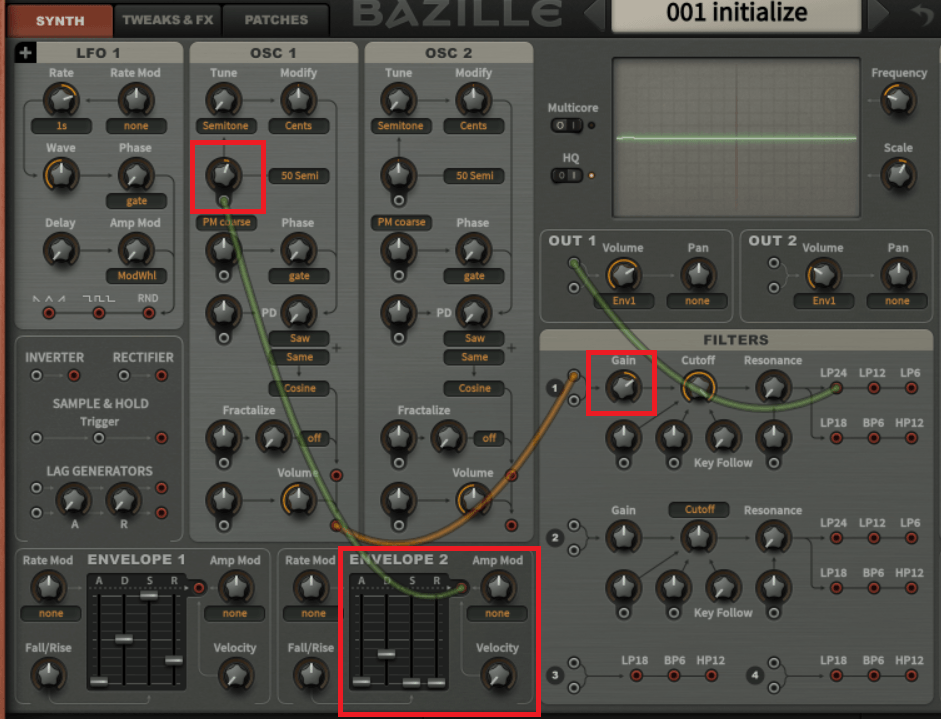
I added some distortion fx.
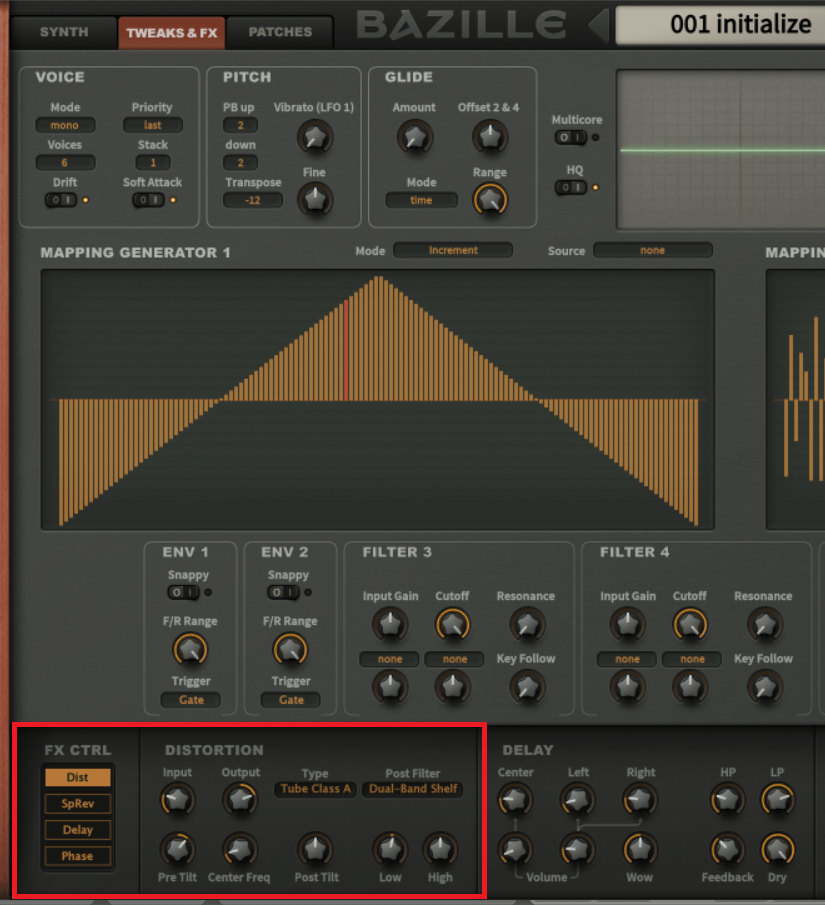
Pulsating drone tone
This is an example of drone/tone using 2 oscillators, that uses an LFO to modify the PM on one oscillator for pulse-width style effect.
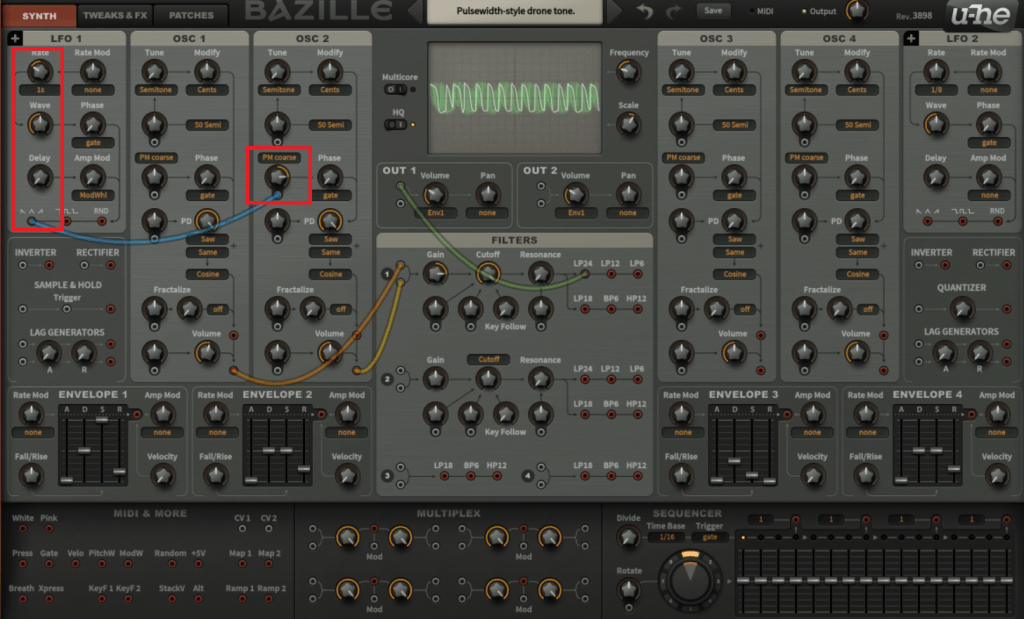
Note Stack
This shows Bazille’s Stack Voice Tuning section for detuned sounds.
Bazille has the ability to add more voices and then detune them. Here I set the stack to 3 and then changed the first 3 voices – to 0, 3 and 7 semitones so now Bazille plays a minor chord when pressing just one key.
You can get really phat detuned sounds this way too – try a 3 note stack but with voice 1 at 0, voice 2 at -0.50 and voice 3 at 0.50.
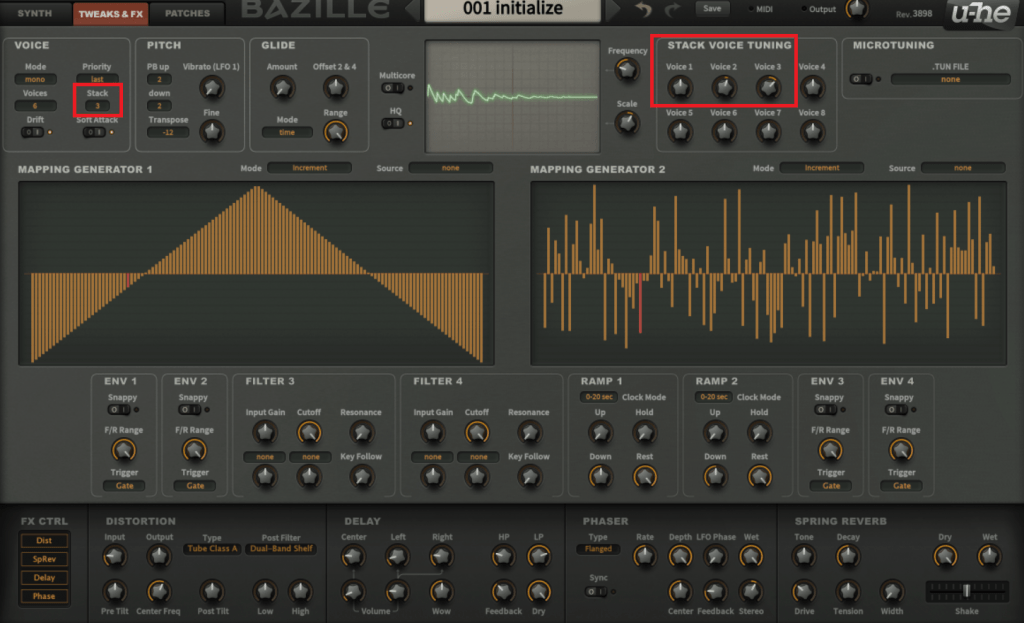
Techno Chord
This preset uses the oscillators and note stack as above to make a thick minor chord.
This techno chord uses the note stack as mentioned above and develops it. There are 4 oscillators: playing a chord (and a note an octave down so the semitone tunings are set at 0,7,15,24 ). They are mixed on the mulitplex and sent through a filter (with envelope 2 bringing the filter down fairly quickly).
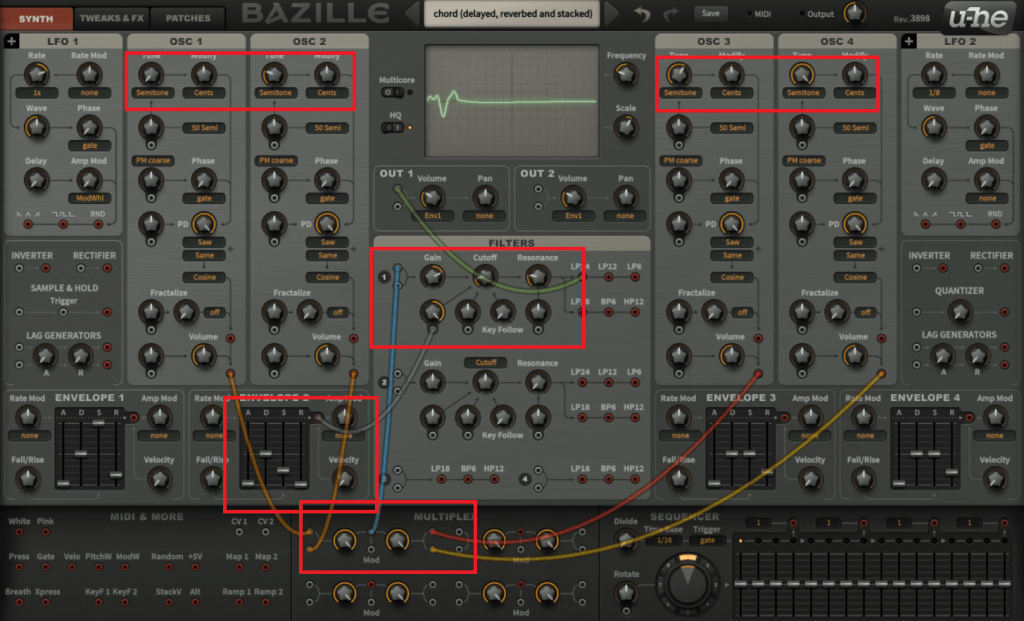
For further thickening of the chord: the voice stack is set to 2 and voice 2 set to +7 semi tones. I turned up the vibrato a bit so the pitch wobbles slightly. Then the fx section is set to delay the chord then add reverb and then distortion at the end to bring out the reverb and delay.
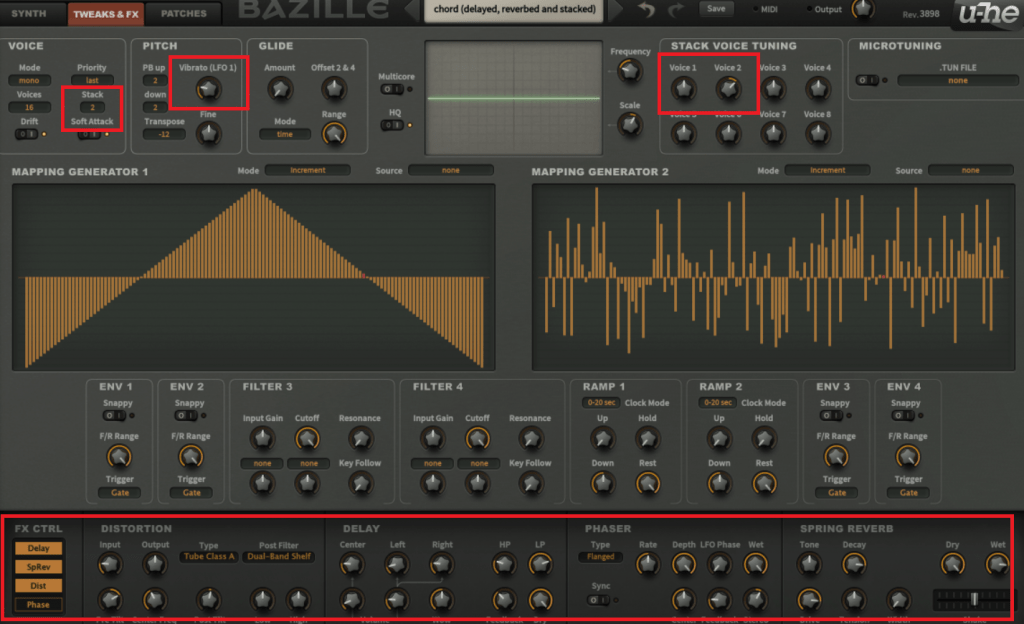
Sequencer
This preset shows a basic sequencer set up. And can be used as a defualt ‘init’ patch for sequences if needed.
This is a basic 8 step sequencer setting. The reason I’m using only 8 notes and not the full 16 for pitch, is I want to use half the sequencer for pitch output and the other half for gate. So I take the first half of the sequencer (the 2nd cable output along) and attach it to the pitch mod of Osc 1. And put the modulation amount to max (50). I attach the second half of the sequencer (the 4th output) to anything – this just makes the sequencer run as it has to be connected to something to make it start. I set up Envelope 2 as the filter envelope.
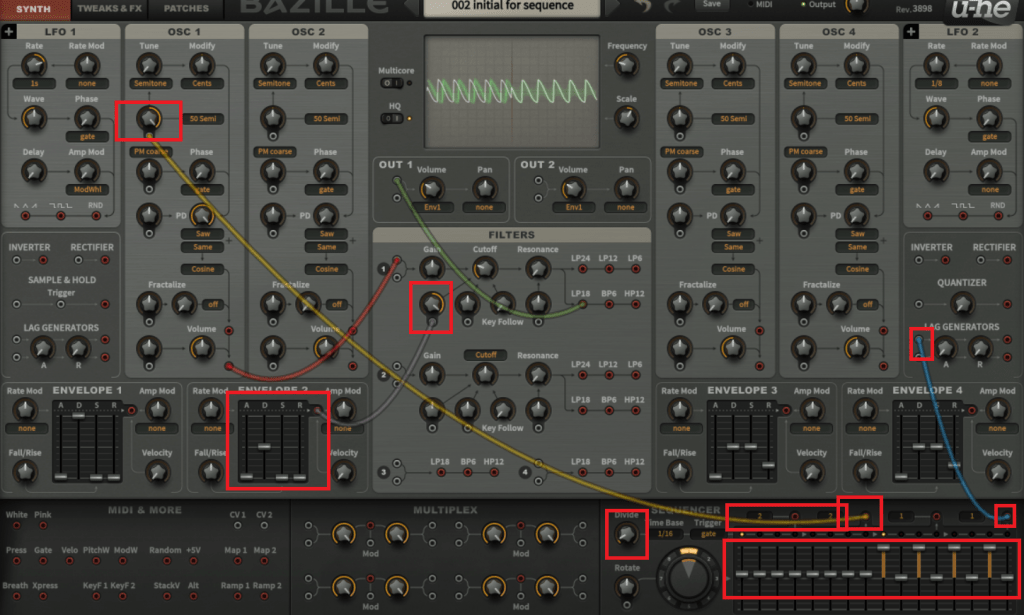
For the sequencer settings: I set Divide to 2, and then the numbers at the top of the sequencer to 2,2,1,1. This means that the second half of the sequencer (the gate) plays back 2x as fast as the others, this is necessary as we need gate on AND gate off for each note (so this part needs twice the resolution). I hope that makes sense, it is quite complicated this bit tbh!
We also need to make sure all the envelopes re-trigger for each gate in the sequence – so in the Tweaks&FX section set ModSeq2 as the Trigger for all 4 envelopes. Now the 2nd half of the sequencer will trigger the filter envelopes.
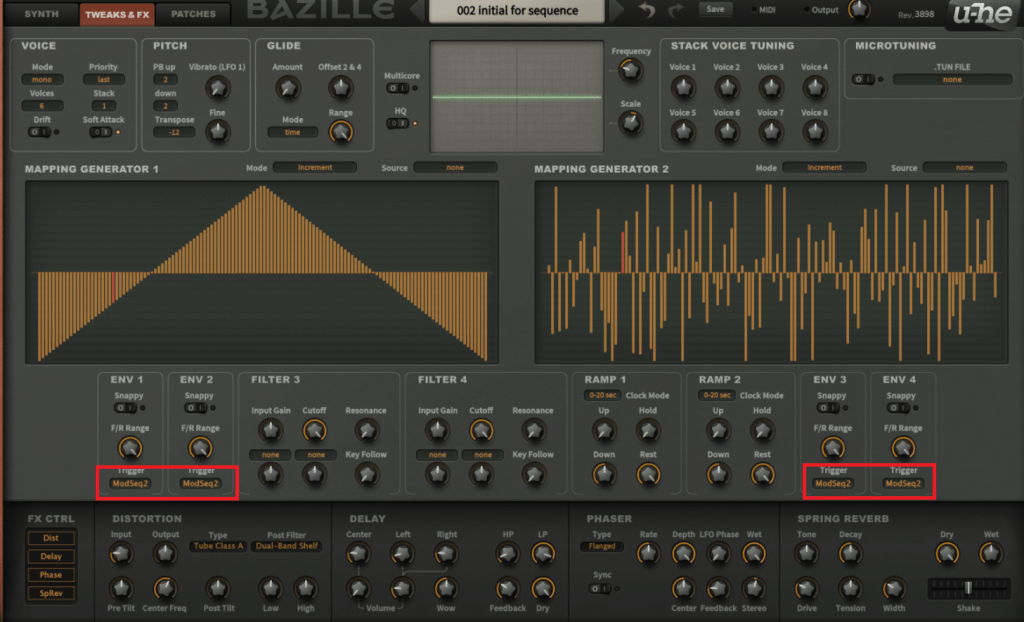
Now you need to play a long note to trigger the sequence (i.e. set a midi note the length of a bar and loop it).
Notes on sequencer pitching : each slider on the sequencer’s value in pitch is half a semitone (with the oscillator pitch modulation at 50 semitones like in the example above). So if you want an octave up (12 semitones) you set the slider at 24. If you want a minor 3rd you set a slider at 6, and a fifth (7 semitones) is 14. Basically double it!
Some other things to try with the sequencer: try these… Envelope 2 – make the decay lower to gate the note tighter. Change the notes and gates in the sequencer – adding in slides can be done by putting up the ‘gate off’ sliders that are currently down at 0. Why not add an oscillator (with the sequencer modifying pitch the same as Osc 1 – set at 50)?
Detuned techno sequence
I love making sequences like this in Bazille. This patch shows how to make a sequence with multiple oscillators.
Here I took the sequence above, and added a second oscillator, I detuned both oscillators slightly by a few cents, and the second one by 6 semitones too. I added some gain in the filter section. I turned the decay in envelope 2 down a bit, then connected the note cv from the sequencer to cutoff modulation, so that the higher notes poke through the filter more. I then changed some notes and added slide (the last 2 faders are up on the gate sequence). Hold down a note and you can hear the slide. This is just to show you slide, as later on I used midi to cut the sequence short so you won’t actually hear this in the example.
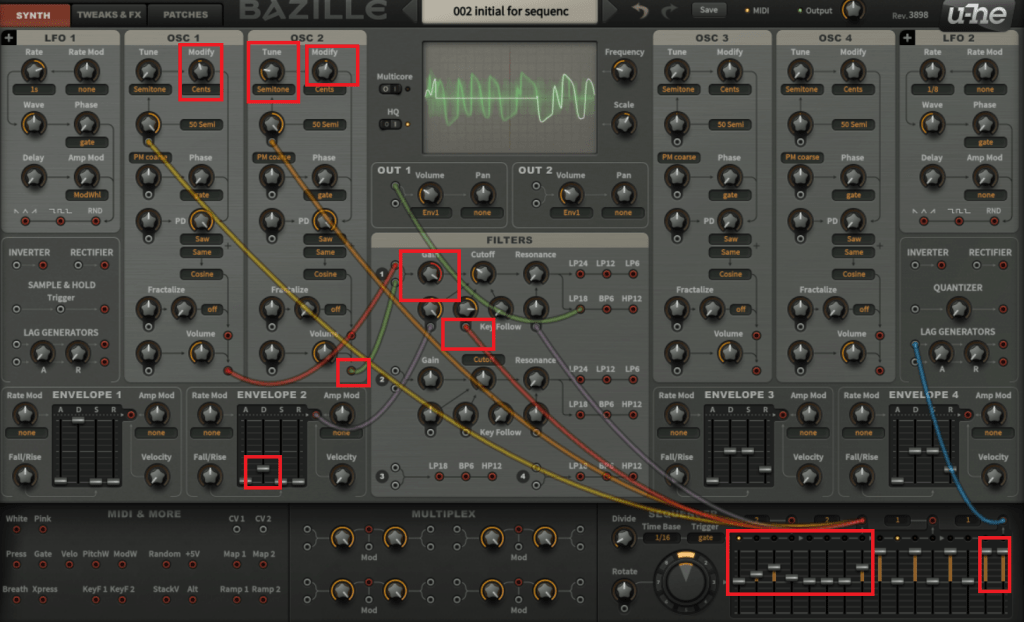
I also added some effects in the fx section.
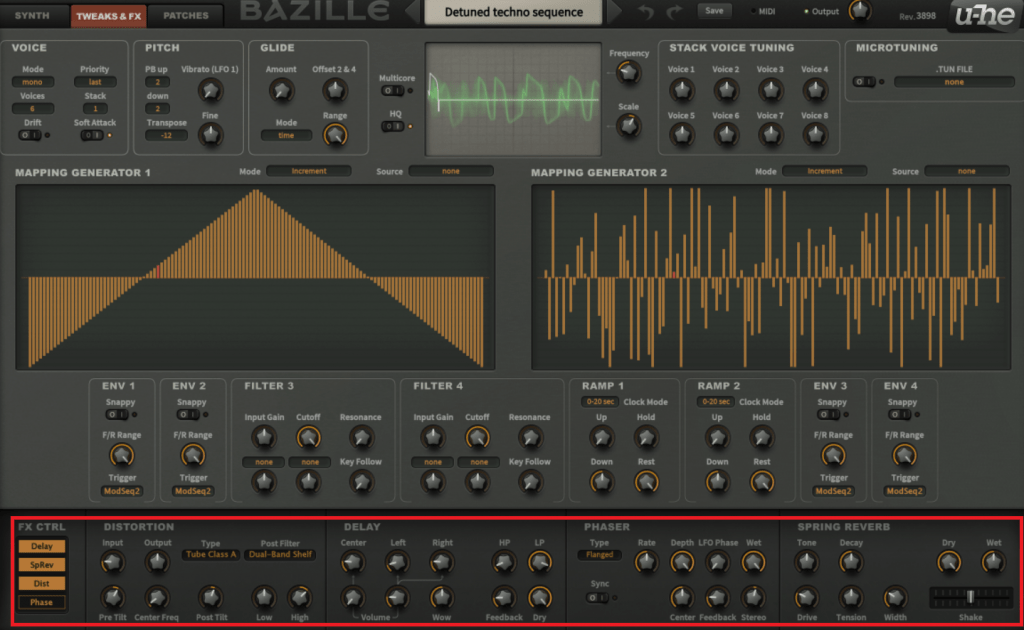
You cannot change the sequence length in Bazille so I did it in midi: I changed the midi to a 3 note sequence (that repeats on the bar).
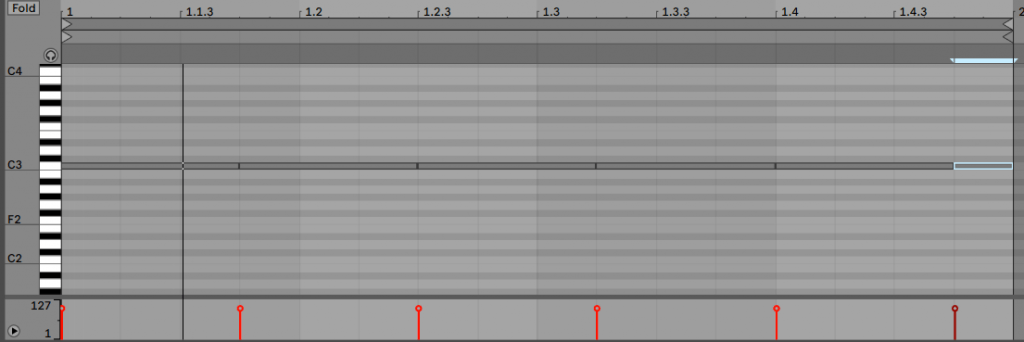
Some other things to try: use different midi notes (maybe length 5?), make some midi notes higher to transpose the sequence. Add in some note stack, and more oscillators etc.
Conclusion
I hope this serves as a good guide to getting started with U-he’s Bazille, I think it is the best plugin around, but you need to stick with it and get over the initial hurdles with the oscillators.
Good luck experimenting, please let us hear what you come up with.
Here’s a few of our other articles you might like… Ableton Wavetable Tutorial, Ableton Operator Tutorial, and Ableton Analog Tutorial.
If you have any questions, please get in contact, or if you have ideas how we can improve this article, hit me up! We’ll probably do a follow up at some point. To contact us – message us on Instagram… https://www.instagram.com/studiobrootle/
We offer online Ableton lessons, get in contact to get the most out of your studio time: Ableton Lessons.